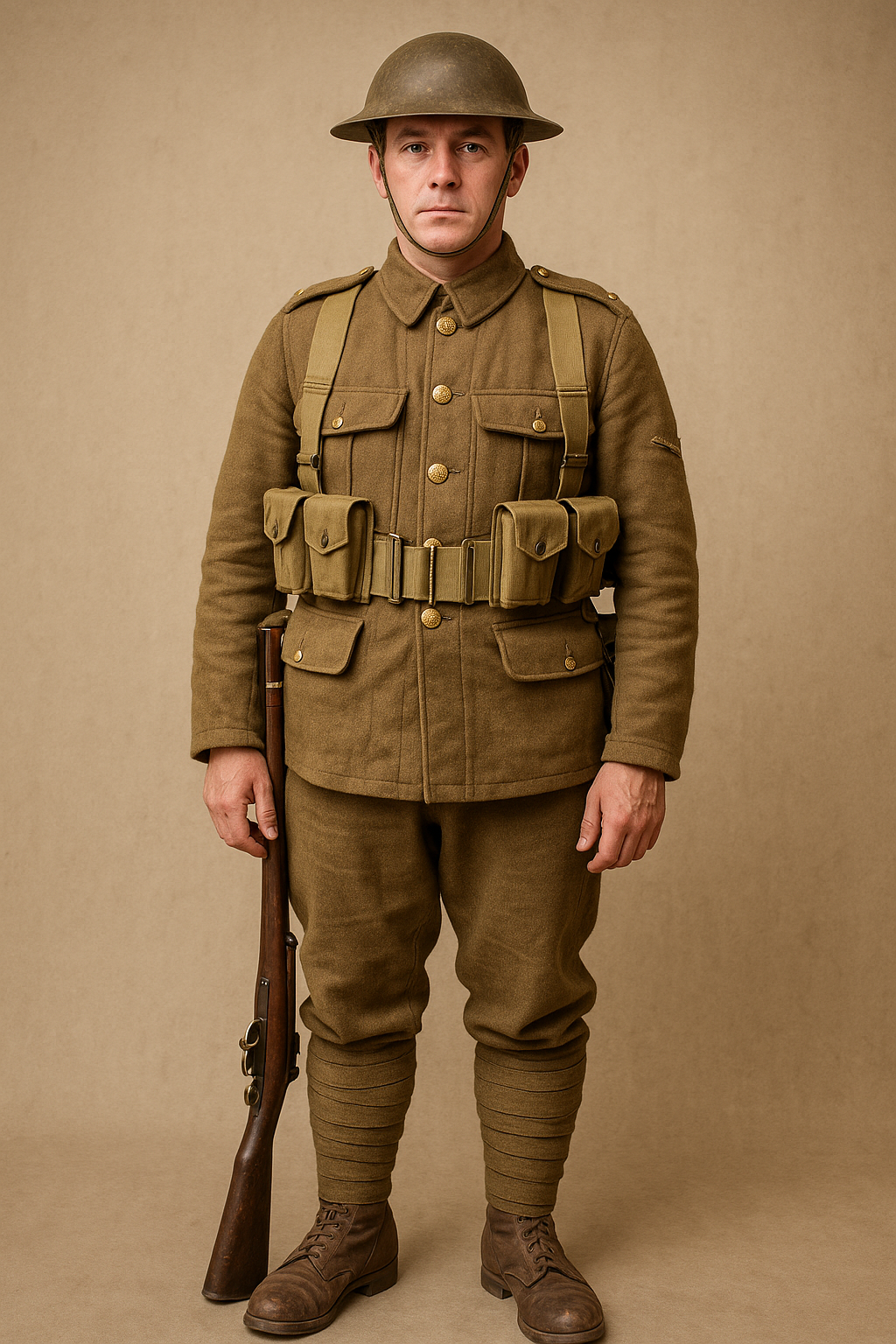
Badges, Buttons, and Identity: The Significance of Regimental Insignia
Published on Oct 12, 2025
Inside the British Soldier's WW1 Uniform: How It Was Made, What It Did, and What It Means
Starting off: The Great War in a Nutshell
When it started in 1914, World War I was different from any other war the world had seen. On the Western Front, millions of men from all over the British Empire were thrown into muddy trenches and bloody fights. What they wore was often just as important to their safety as how well they trained or how brave they were.
Learning about the British soldier's clothing during World War I helps us understand how function, safety, and identity all came together during one of the most difficult times in history. It wasn't just clothes; it was a way to stay alive.
What Makes the British Soldier Uniform Unique? 🥖 Brodie Helmet
As the war went on, soldiers switched from soft caps to the steel Brodie helmet, which came out in 1915. Its shallow, round shape helped block shrapnel and other debris from above, which was very important during gun bombardments. The Brodie helped save lives during the Battle of the Somme in 1916, when soldiers from the 1st Battalion, Royal Fusiliers, wore it.
👋 Tunic for service dress
The khaki wool service tunic that was issued as standard was useful and made to last in rough circumstances. It was cut to be moveable and had big pockets for taking small things. The earthy tone helped the troops blend in with their surroundings. This was something that was learned from wars in the colonies before World War I.
Pattern Webbing from 1908
The 1908 webbing system was a major improvement that made it easier for soldiers to carry things like ammunition, water bottles, food, and tools for digging trenches. Its even spread of weight was very important during long marches and life in the trenches.
🥍 Golf clubs and boots
Pairing sturdy leather ankle boots with cloth puttees (long strips wrapped around the lower legs) gave the ankles support and kept mud and bugs out. They were very important in the cold, wet ditches of Flanders, even though they were often uncomfortable when they got wet.
Regimental badges and insignia
Insignias from the company and sometimes patches from the division were worn on uniforms. This helped keep unit identity in the chaos of war. Soldiers were proud of these details, which brought them closer to their hometowns and customs.
Why the British soldier uniform was good and bad ✠
Rugged and useful: made for rough conditions and long missions.
Better protection: The Brodie helmet and thick wool tunic protected the wearer well from gunfire and bad weather.
Functional load carrying: Webbing made it easy for soldiers to carry their important gear.
Camouflage benefit: the khaki color helped people hide on the battlefield.
▌ Bad Things
With everything on, a fighter could carry up to 30 kg of heavy, uncomfortable gear.
Wool didn't hold water well, which made life in the trench awful in the rain and snow.
Not very much protection: The uniform was better, but it wasn't very good at protecting against bullets or gas attacks.
The Imperial War Museum Collection is a real-life example.
In London's Imperial War Museum, you can see real uniforms from units like the King's Own Yorkshire Light Infantry. Many of them have mud stains, trench wear, and field repairs that show they were used in fights like Ypres and Passchendaele. These well-preserved items give us a real link to what soldiers went through more than a hundred years ago.
Some Frequently Asked Questions About the British Soldier Uniform in World War I
Why was the outfit khaki?
British soldiers used khaki instead of bright red coats to better blend in with their surroundings during modern fighting.
2. Did each soldier have the same uniform?
The basics were the same, but there were differences based on rank, unit, and time period. Officers often had versions that were made just for them out of better materials.
What was the frequency of clothing replacement?
When you joined the army, you got a uniform, and when it got worn out, you got a new one. However, on the front lines, changes didn't always happen on time.
Four. What did men carry with them?
Along with the gear they were given, troops often carried letters, photos, small Bibles, or lucky charms as reminders of home and hope during the war.
5. Did the outfit change while the war was going on?
Yes. Early models didn't have hats or other useful gear. By 1916, changes like the Brodie hat and a new design for the webbing were commonplace.
Conclusion: The Legacy of an Old Uniform
The British soldier uniform during World War I was more than just fabric and steel. It was an important part of their character, their ability to stay alive, and their ability to keep going. Even though it was not perfect, it was a turning point in the design of military gear and set the stage for current combat uniforms. People who wore it through one of history's darkest times have left behind museums, monuments, and stories about what they went through.
